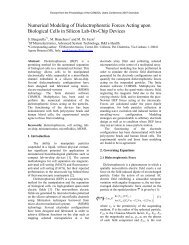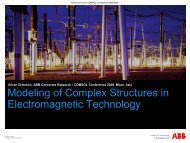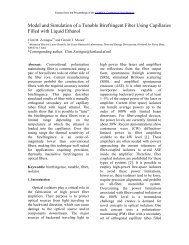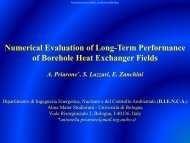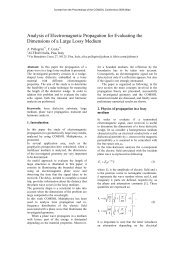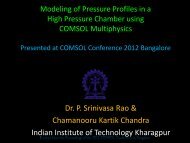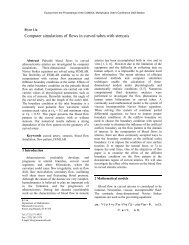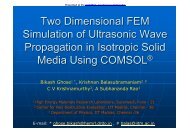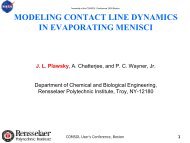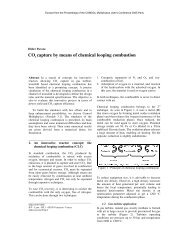Multiphysics Model Bolometer for Detecting the ... - COMSOL.com
Multiphysics Model Bolometer for Detecting the ... - COMSOL.com
Multiphysics Model Bolometer for Detecting the ... - COMSOL.com
Create successful ePaper yourself
Turn your PDF publications into a flip-book with our unique Google optimized e-Paper software.
<strong>Multiphysics</strong> <strong>Model</strong>ing and Simulation of MEMS Based<br />
<strong>Bolometer</strong> <strong>for</strong> <strong>Detecting</strong> <strong>the</strong> Radiations in Nuclear Power Plants<br />
K. Umapathi 1* , S. Swetha 2# 2 , K. Ranjitha 2 , K. Vinodh 2 , K. Deebiga 1 , R. Harisudarsan 1<br />
1 Department of Electrical and Electronics Engineering.<br />
United Institute of Technology, Coimbatore.<br />
*E-mail: umapathi.nanotech@gmail.<strong>com</strong><br />
Department of Electronics and Communication Engineering.<br />
2 Sri Krishna College of Engineering and Technology, Coimbatore.<br />
# E-mail: E swethasuha@gmail.<strong>com</strong><br />
Abstract: High per<strong>for</strong>mance micro sensors are<br />
important <strong>for</strong> detecting nuclear radiations in<br />
different fields to save <strong>the</strong> globe. This paper is<br />
mainly focused on to develop a MEMS based<br />
device <strong>for</strong> detecting <strong>the</strong> nuclear radiation to provide<br />
high security around Nuclear power Plants.<br />
Two Thermally sensitive micro metal plates of<br />
different coefficient of expansion are joined<br />
toge<strong>the</strong>r and placed on both sides of a link<br />
connected to <strong>the</strong> substrate. . The energy of <strong>the</strong><br />
incident radiation ation heats <strong>the</strong> micro plates which<br />
make <strong>the</strong>m to deflect. Copper links are provided on<br />
ei<strong>the</strong>r side of <strong>the</strong> substrate. The deflection produces<br />
contact with <strong>the</strong> copper links and <strong>the</strong> changes <strong>the</strong><br />
voltage across it.<br />
Three different material pairs were studied and<br />
modeled. They are Aluminium-Tungsten, Silver-<br />
Tungsten and Lead-Tungsten. Among <strong>the</strong>m<br />
Aluminium-Tungsten pair exhibited satisfied<br />
results over conventional detectors. It can be also<br />
used <strong>for</strong> detecting hazardous radiation from Base<br />
Transceiver Stations. The micro plate and micro<br />
<strong>the</strong>rmal links are designed and simulated using <strong>the</strong><br />
Heat transfer and Structural Mechanics physics in<br />
<strong>COMSOL</strong> <strong>Multiphysics</strong>.<br />
radiation. . Figure 1 shows <strong>the</strong> amount of radiation<br />
from various sources. They consist of particles<br />
(alpha, beta and neutron) as well as short<br />
wavelength waves (gamma). Their energy is high<br />
enough to ionize molecules and cause biological<br />
damage. Exposure to ionizing radiation causes<br />
damage to living tissue, and can result in mutation,<br />
radiation sickness, cancer and death. Various<br />
techniques are used to detect <strong>the</strong>m [1, 2]. In this<br />
paper we have used <strong>the</strong> <strong>Bolometer</strong> to detect <strong>the</strong><br />
presence of Nuclear Radiation.<br />
Keywords: Coefficient of <strong>the</strong>rmal expansion<br />
(CTE), MEMS, Nuclear radiations.<br />
1. INTRODUCTION:<br />
1.1 Nuclear radiation hazards:<br />
Nuclear reactors produce large quantities of<br />
ionizing radiation. During normal operations of<br />
nuclear power plant, penetrating radiation (like<br />
gamma and X-rays) emitted from <strong>the</strong> radioactive<br />
materials in <strong>the</strong> reactor and in <strong>the</strong> systems and<br />
buildings of <strong>the</strong> plant may be able to expose<br />
someone outside <strong>the</strong> boundary of <strong>the</strong> plant.<br />
Ionizing radiation is invisible and not directly<br />
detectable by human senses. Nuclear radiation<br />
accounts <strong>for</strong> about 0.16% of total ionizing<br />
Figure 1: Radiation sources<br />
A bolometer is a device <strong>for</strong> measuring <strong>the</strong> power<br />
of incident radiation. It consists of an absorptive<br />
element, such as a thin layer of metal, connected to<br />
<strong>the</strong> <strong>the</strong>rmal reservoir through a link. <strong>Bolometer</strong> is<br />
directly sensitive to <strong>the</strong> energy left inside <strong>the</strong><br />
absorber. Compared to more conventional particle<br />
detectors <strong>the</strong>y are extremely efficient in energy<br />
resolution and in sensitivity.<br />
This paper gives <strong>the</strong> design of <strong>the</strong> absorptive<br />
element of <strong>the</strong> <strong>Bolometer</strong>. The principle of this<br />
device is based on <strong>the</strong> <strong>the</strong>rmal coefficient of<br />
expansion of metals.<br />
Excerpt from <strong>the</strong> Proceedings of <strong>the</strong> 2012 <strong>COMSOL</strong> Conference in Bangalore
1.2 Actuating metal plates<br />
Thermal micro actuators <strong>for</strong>m<br />
potential applications <strong>for</strong> large and linear<br />
displacements. The device consists of two micro<br />
plates on ei<strong>the</strong>r side of <strong>the</strong> support. The two micro<br />
plates are made of materials of different coefficient<br />
of <strong>the</strong>rmal expansion (CTE). Thermal expansion is<br />
<strong>the</strong> tendency of matter to change in volume in<br />
response to a change in temperature. When a<br />
substance is heated, its particles begin moving<br />
more and thus usually maintain a greater average<br />
separation. Materials which contract with<br />
increasing temperature are rare; <strong>the</strong>se effects are<br />
limited in size, and only occur within limited<br />
temperature ranges. The degree of expansion<br />
divided by <strong>the</strong> change in temperature is called <strong>the</strong><br />
material's coefficient of <strong>the</strong>rmal expansion and<br />
generally varies with temperature. The coefficient<br />
of <strong>the</strong>rmal expansion describes how <strong>the</strong> size of an<br />
object changes with a change in temperature.<br />
Specifically, it measures <strong>the</strong> fractional change in<br />
size per degree change in temperature at a constant<br />
pressure. In <strong>the</strong> general case of a gas, liquid, or<br />
solid, <strong>the</strong> volumetric coefficient of <strong>the</strong>rmal<br />
expansion is given by<br />
The subscript p indicates that <strong>the</strong> pressure is held<br />
constant during <strong>the</strong> expansion, and <strong>the</strong> subscript<br />
"V" stresses that it is <strong>the</strong> volumetric (not linear)<br />
expansion. Materials generally change <strong>the</strong>ir size<br />
when subjected to a temperature change while <strong>the</strong><br />
pressure is held constant. In <strong>the</strong> special case<br />
of solid materials, <strong>the</strong> pressure does not<br />
appreciably affect <strong>the</strong> size of an object. The<br />
design has materials with different CTEs<br />
sandwiched toge<strong>the</strong>r. . When temperature<br />
excursions occur, because of changes in ei<strong>the</strong>r<br />
ambient condition, , <strong>the</strong>se materials will expand<br />
differently, leading g to <strong>the</strong> creation of stresses.<br />
Figure 2 shows <strong>the</strong> deflection of metals when<br />
heat is applied. In this paper different metal pairs<br />
are studied and <strong>the</strong>ir deflections due to application<br />
of heat are detected.<br />
2. DESIGN:<br />
Figure3: Design<br />
The schematic diagram of <strong>the</strong> designed model is<br />
illustrated in <strong>the</strong> figure 3. It consists of silicon<br />
substrate which has a support at <strong>the</strong> centre to hold<br />
<strong>the</strong> micro plates. One of <strong>the</strong> micro plates is made of<br />
material with high CTE and <strong>the</strong> o<strong>the</strong>r is made of<br />
material of low CTE. . Ano<strong>the</strong>r such plate is<br />
designed and placed on ei<strong>the</strong>r side of silicon<br />
support. Copper links are provided on ei<strong>the</strong>r side of<br />
<strong>the</strong> substrate <strong>for</strong> contacts.<br />
Three pairs of such plates were designed and<br />
modelled separately and <strong>the</strong> results were <strong>com</strong>pared.<br />
The three metal pairs were Aluminium-Tungsten,<br />
Silver-Tungsten and Lead-Tungsten. The<br />
difference between <strong>the</strong> coefficients of <strong>the</strong>rmal<br />
expansion between <strong>the</strong> two micro<br />
metal plates<br />
determines <strong>the</strong> per<strong>for</strong>mance of <strong>the</strong> <strong>Bolometer</strong>. The<br />
properties of <strong>the</strong> materials used in <strong>the</strong> model are<br />
tabulated in <strong>the</strong> table 1, 2 and 3.<br />
Mechanical properties:<br />
PROPERTY Al W Pb<br />
Young’s 70G 411G<br />
16G<br />
Modulus Pa Pa<br />
Pa<br />
Ag<br />
83G<br />
Pa<br />
Poisson’s<br />
ratio<br />
0.33<br />
0.27<br />
0.44<br />
0.37<br />
Table1: Mechanical properties<br />
Figure2: Expansion of metals<br />
Excerpt from <strong>the</strong> Proceedings of <strong>the</strong> 2012 <strong>COMSOL</strong> Conference in Bangalore
Thermal properties:<br />
PROPERTY ALUMINIUM TUNGSTEN<br />
Thermal<br />
conductivity<br />
Heat<br />
capacity<br />
Coefficient<br />
of <strong>the</strong>rmal<br />
expansion<br />
Density<br />
160[W/mK]<br />
900[J/kg*K]<br />
23e-6[1/K]<br />
2700[Kg/m^3]<br />
173[W/mK]<br />
1340[J/kg*K]<br />
4.5e-6[1/K]<br />
17800[Kg/m^3]<br />
Table2: Thermal properties of Aluminium and<br />
Tungsten<br />
PROPERTY LEAD SILVER<br />
Thermal<br />
conductivity<br />
Heat<br />
capacity<br />
Coefficient<br />
of <strong>the</strong>rmal<br />
expansion<br />
Density<br />
35.3[W/mK]<br />
127[J/kg*K]<br />
28.9e-6[1/K]<br />
11340[Kg/m^3]<br />
429[W/mK]<br />
235[J/kg*K]<br />
18.9e-6[1/K]<br />
10500[Kg/m^3]<br />
Table3: Thermal properties of Lead and Silver<br />
Aluminium-Tungsten pair has <strong>the</strong> highest<br />
difference in <strong>the</strong>ir coefficient of <strong>the</strong>rmal expansion.<br />
MEMS module is used to design this sensor.<br />
Thermal stress physics is applied in order to<br />
simulate <strong>the</strong> results with <strong>the</strong> input parameters.<br />
Three such designs were modelled using different<br />
<strong>com</strong>binations of micro plates. Their corresponding<br />
results were <strong>com</strong>pared. Table 4 gives <strong>the</strong><br />
dimensions of <strong>the</strong> design. Substrate is of dimension<br />
100x100x11µm. Micro plates are of dimensions<br />
45x20x1µm.<br />
Parameters<br />
Values(µm)<br />
Width of <strong>the</strong> substrate 100<br />
Depth of <strong>the</strong> substrate 100<br />
Height of <strong>the</strong> substrate 11<br />
Width of <strong>the</strong> metal plate 45<br />
Depth of <strong>the</strong> metal plate 20<br />
Height of <strong>the</strong> metal plate 1<br />
Width of <strong>the</strong> copper link 10<br />
Depth of <strong>the</strong> copper link 20<br />
Height of <strong>the</strong> copper link 13<br />
Width of <strong>the</strong> central support 20<br />
Depth of <strong>the</strong> central support 20<br />
Height of <strong>the</strong> central support 20<br />
Table4: Design parameters<br />
4. Results:<br />
The incident radiation produces heat on <strong>the</strong> metal<br />
plates uni<strong>for</strong>mly. Owing to <strong>the</strong> change in<br />
coefficient of <strong>the</strong>rmal expansion, <strong>the</strong> plates deflect<br />
accordingly. This makes a contact with <strong>the</strong> copper<br />
links at <strong>the</strong> end of <strong>the</strong> substrate. A readout circuit<br />
can be used to detect <strong>the</strong> changes in deflection. The<br />
deflection of <strong>the</strong> plates <strong>for</strong> different pairs of<br />
materials was observed.<br />
3. USE OF <strong>COMSOL</strong> MULTIPHYSICS:<br />
Figure4: Geometry model<br />
Figure 4 shows <strong>the</strong> designed model <strong>for</strong> this<br />
application. The design is implemented and<br />
simulated using <strong>COMSOL</strong> <strong>Multiphysics</strong> software.<br />
Figure5:Displacement by Aluminium-Tungsten plate.<br />
Excerpt from <strong>the</strong> Proceedings of <strong>the</strong> 2012 <strong>COMSOL</strong> Conference in Bangalore
4<br />
TOTAL DISPLACEMENT<br />
3.5<br />
Figure6: Displacement by Silver-Tungsten plate<br />
DISPLACEMENT(µm)<br />
3<br />
2.5<br />
2<br />
1.5<br />
1<br />
Al<br />
Pb<br />
Ag<br />
0.5<br />
0<br />
300 340 380 420 460 500 540 580 620<br />
TEMPERATURE (K)<br />
Figure8: Temperature versus Displacement Graph<br />
Figure 8 shows <strong>the</strong> displacement of <strong>the</strong> three<br />
pairs of metals <strong>for</strong> different temperatures.<br />
Figure7: Displacement by Lead-Tungsten plate<br />
Figures 5, 6 and 7 show <strong>the</strong> deflection of<br />
Aluminium-Tungsten, Silver-Tungsten and Lead-<br />
Tungsten plates <strong>for</strong> a temperature of 500K. The<br />
maximum displacement was observed in<br />
Aluminium-Tungsten pair. This was due to <strong>the</strong><br />
large difference in <strong>the</strong>ir coefficient of <strong>the</strong>rmal<br />
expansion of Aluminium and Tungsten. The<br />
displacements <strong>for</strong> various metal pairs at different<br />
temperatures are given in table 5.<br />
Temperature Displacement(µm)<br />
(K) Al-W Pb-W Ag-W<br />
300 0.0567 0.035 0.0486<br />
320 0.193 0.1176 0.1654<br />
340 0.5045 0.411 0.4178<br />
360 0.827 0.5862 0.5957<br />
380 0.9345 0.7614 0.7736<br />
400 1.1473 0.9352 0.9496<br />
420 1.3646 1.1118 1.1294<br />
440 1.5796 1.287 1.3073<br />
460 1.7947 1.4622 1.4853<br />
480 2.0097 1.6373 1.6632<br />
500 2.2247 1.8125 1.8411<br />
520 2.4398 1.9877 2.019<br />
540 2.6548 2.1629 2.1969<br />
560 2.8698 2.3881 2.3748<br />
580 3.0849 2.5133 2.5528<br />
600 3.2999 2.6885 2.7307<br />
Table5: Displacement <strong>for</strong> various pairs of metals.<br />
5. CONCLUSION:<br />
The absorption plate of <strong>the</strong> <strong>Bolometer</strong> was<br />
designed and modeled using <strong>COMSOL</strong><br />
<strong>Multiphysics</strong> Software. The micro plates exhibit<br />
deflection <strong>for</strong> various temperature ranges. The<br />
deflection gives contact with copper links. The<br />
changes due to temperature and displacement are<br />
studied and plotted. De<strong>for</strong>mation is observed on<br />
both sides. A read-out circuit can be used to detect<br />
<strong>the</strong> change in deflection. Three such models were<br />
designed using different materials. The metal pairs<br />
used were Aluminium-Tungsten, Lead-Tungsten<br />
and Silver-Tungsten. Among <strong>the</strong>m, <strong>the</strong> model with<br />
Aluminium-Tungsten pair exhibited faster response<br />
than <strong>the</strong> o<strong>the</strong>r pairs.<br />
5. References:<br />
1. Michael Foxe, , Gabriel Lopez, Isaac Childres,<br />
Romaneh Jalilian, Caleb Roecker, John Boguski,<br />
Igor Jovanovic#, and Yong P. Chen# , Member,<br />
IEEE- Detection of Ionizing Radiation Using<br />
Graphene Field Effect Transistors.<br />
2. R. Reichle, T. Nishitani, E.R. Hodgson, L.C.<br />
Ingesson, E. Ishitsuka, S. Kasai, K.F. Mast,<br />
T. Shikama, J.C. Vallet, S. Yamamoto, Radiation<br />
hardness test of mica bolometers<br />
<strong>for</strong> ITER in JMTR, in: 28th EPS Conference on<br />
Contr. Fusion and Plasma PhysFunchal, 2001<br />
Excerpt from <strong>the</strong> Proceedings of <strong>the</strong> 2012 <strong>COMSOL</strong> Conference in Bangalore



![[PDF] Microsoft Word - paper.docx - COMSOL.com](https://img.yumpu.com/50367802/1/184x260/pdf-microsoft-word-paperdocx-comsolcom.jpg?quality=85)
